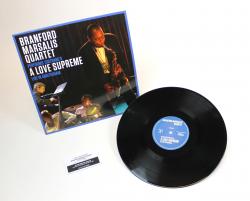 Coltrane’s A Love Supreme: Live in Amsterdam reissue from the Branford Marsalis Quartet out now and available on vinyl for the very first time Read more »
Coltrane’s A Love Supreme: Live in Amsterdam reissue from the Branford Marsalis Quartet out now and available on vinyl for the very first time Read more »
American Stories of Mixed Identity, Explored Through Mixed Media
Publication: The New York Times
Author: Ben Ratliff
Date: February 7, 2012
MONTCLAIR, N.J. — It’s been a while since the saxophonist and composer Miguel Zenón has written a tune that wasn’t about something bigger than itself. Generally, he works without words or straight narrative — his medium is the small-to-medium-size jazz group — but he makes his music embody something: a process, a lesson, an idea.
Mr. Zenón was born and raised in Puerto Rico, and usually his bigger thoughts have arrived in the form of roots-minded albums, like his three records about aspects of his island’s musical culture: “Jíbaro” (2005), about the song form of back-country troubadours; “Esta Plena” (2009), about his island’s voice-and-percussion tradition; and “Alma Adentro” (2011), about Puerto Rico’s 20th-century standards.
On Saturday night at the Alexander Kasser Theater at Montclair State University he took the next organizational and conceptual step forward into a 90-minute multimedia work, “Puerto Rico Nació en Mi: Tales From the Diaspora.”
Performed for the first time, it involved his quartet, a 12-piece big band and video backdrop; it was commissioned by Peak Performances, Montclair State’s performing arts series. Mr. Zenón hasn’t written for big band before, or done the kind of deep cross-media collaboration going on here, between his music and the work of the video artist David Dempewolf. (Mr. Dempewolf worked on another jazz-related piece several years ago, Jason Moran’s “In My Mind.”) But already the project seems about as good as it could reasonably be in concept and execution.
“Puerto Rico Nació en Mi” (“Puerto Rico Was Born in Me”) is about living contrapuntally: the split focus of Puerto Rican Americans’ cultural identity; the basic question of who someone really is, by virtue of family, language, ritual, neighborhood and memory.
In the piece Mr. Zenón uses the idea of multiplicity as a metaphor by writing overlapping rhythmic cycles (a three against a two, a five against a seven); by interweaving the roles of the small and big bands; and, to a lesser extent, by making the music and the video play off each other.
Mr. Dempewolf’s video backdrop alternated and sometimes overlaid images of Puerto Rico and New York, using what looked like a rotoscoping program that gave the images an animated quality; it also included interviews with seven Puerto Rican Americans, responding to questions about how connected they felt to Puerto Rican culture and whether or when they spoke Spanish. (They included Mr. Zenón’s sister, Patricia; the bassist Luques Curtis; the New York University Latino Studies academic Juan Flores; and Sonia Manzano, the actress who played Maria on “Sesame Street.”)
Their comments helped form the titles of the piece’s movements and indirectly gave shape to the themes in the music. (Sometimes they literally got into the music: Mr. Zenón had a set of foot pedals to trigger words and phrases from the interviews.)
The answers could be conversational or eloquent; occasionally there were pileups of word-and-sound-based information, as in the second section, “Identities Are Changeable,” when Mr. Flores’s remarks — about how cultivating a multiple identity isn’t the same thing as opportunism — distracted your ears from the beauty of a brass chorale.
The interviews could have been better shot or better edited; they could have connected with the music more deeply. But they didn’t carry the piece, because they didn’t have to. Mr. Zenón’s quartet, without the big band, has been playing the new material for six months, molding it within its own articulate sound and language.
And on Saturday that sound and language didn’t directly suggest traditional Puerto Rican music or traditional jazz. Its rhythm was phrased almost completely in stacked or odd meter, with parts of the band shifting into double or half time, and Mr. Zenón’s saxophone darting around the chord changes or resting on top, in long tones.
There was drama and momentum in the music’s developing harmonic movement; at times a shift to a new chord felt like an event. All the music was deeply hybridized and original, complex but clear.
Categories
Tags in Tags
Branford Marsalis Branford Marsalis Quartet ellis marsalis four mfs playin' tunes Joey Calderazzo Justin Faulkner Marsalis Family marsalis music metamorphosen miguel zenon music redeems new orleansFilter by Artist
Marsalis Music Radio
Join Our Mailing List
- RT @bmarsalis: Compliments of the @T_Blanchard archives. https://t.co/4RsXbyEloa — 3 years 12 weeks ago MarsalisMusic